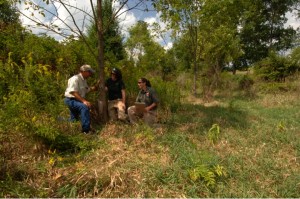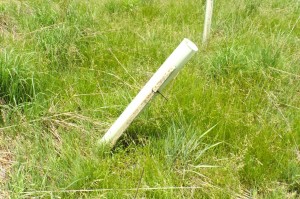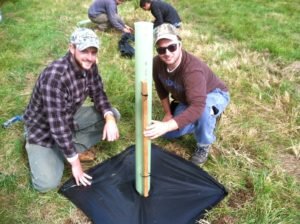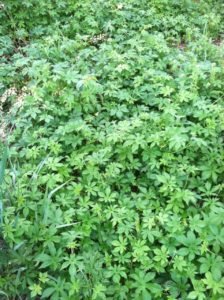I have been involved with over 500 miles of riparian buffer plantings and have witnessed plenty of failures and successes. I would like to share with you what I believe is the recipe for success, that being TREE CANOPY CLOSURE IN TEN YEARS.

The author with Spencer Thompson of Conservation Services and VDOF Forester Patti Nylander. Mocomp Farm, eight-year-old riparian tree planting. Click on the image to watch a one minute video.
I’ll get right to the point then provide details.
- First of all and most importantly you have to plant the right tree, the right way in the right place.
- Second, control invasive weeds that are harmful to your seedling.
- Lastly, maintain your tree shelters.
If you do these three simple things I believe you will achieve seventy percent tree canopy closure in ten years.
Now for the details: In the Chesapeake Bay watershed, we know from science that forested buffers along streams are one of the best practices for filtering out pollutants before they reach the stream and they supply the inputs to the stream that support a healthy aquatic ecosystem. A healthy aquatic ecosystem is two to eight times more capable of detoxifying itself than one without. The drivers of this aquatic ecosystem are leaves from native trees; it’s the energy source or bottom of the aquatic food chain. No leaves, no macroinvertebrates, no fish.
By planting native hardwoods along a stream we are helping Mother Nature establish a forest in ten years instead of thirty to fifty years.
Let’s look at what we are up against. In pasture, hayland or meadow we are inserting a two to three-year-old seedling into a sea of mature grassroots. One of the most prevalent grasses in the Bay watershed is Tall Fescue and we know that it is allelopathic towards tree seedlings. Un-mowed grassland is also great habitat for meadow voles – one of your worst enemies. Rabbits and deer will also cause harm to the seedlings.
Suppressing Tall Fescue helps your seedling by reducing toxins in the soil and removing vole habitat.
What causes tree seedling failure?
Number one cause: No tree shelter.
Science tells us that tree shelters are a must. Without shelters expect 70% mortality. With properly installed shelters expect only 10 to 30% mortality.
Number two cause: improperly installed tree shelter.

One of the leading causes of tree seedling failure is a broken shelter stake because it leaves an opening at the ground for meadow voles to enter the shelter.
Shelters need to be in the ground two the three inches below the soil surface. This prevents voles and mice from entering the shelter and killing the seedling.
Number three cause: a broken tree shelter stake.
When the tree shelter stake breaks it leaves an opening for voles. Use only White Oak stakes or pressure treated stakes. Replace broken stakes as soon as possible.
Number four cause: inferior seedling or wrong tree species for the site.
Tree seedlings need to be at least ¼ inch in diameter at the collar or 18 inches tall. Select the right tree for the soil type, e.g. don’t plant a White Oak in a poorly drained soil.
I already mentioned the toxicity of Tall Fescue to tree seedlings. It is important to suppress fescue in some way. A vigorous scalping of the sod prior to planting, use of a turf mat, herbicide treatment, tillage or some other method can do this.

Kyle Switzer and Cam Morton of James Madison University planted a bare-root tree seedling with a four foot “Tubex” tree shelter. They also used a 3’X3″ turf mat. The turf mat helps suppress tall fescue sod.
There are other invasive weeds that can choke out the seedling and it is important to keep these weeds in check. They include Japanese Hops, Carpetweed and Field Bindweed. These are vines and simply smother the seedling.

Japanese Hops; one of the most invasive weeds in riparian buffers. Click on the image to watch a two-minute video on invasives.
I believe we should also suppress invasive weeds that are unacceptable to the community because it gives the programs a bad image. These include non-native Thistles, Teasel, Autumn Olive and others. Be a good neighbor; keep these weeds under control – it will help others want to plant buffers on their land.
Riparian forest buffers are key to a restored stream in your community and restored Chesapeake Bay – the largest estuary in America.
Let me know if I can help you establish riparian buffers on your land.
© Robert N. Whitescarver

105 Comments
Leave your reply.